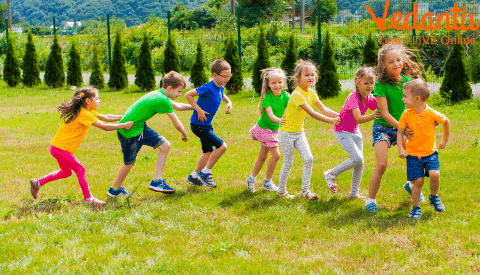




Why Engaging Activities Matter in Nursery Education
Nursery class kids are the most interesting creatures on the planet because they may not be able to speak their minds in the most coherent of ways, but their thoughts are complex and creative, and all-around interesting.
Nursery class teaching 30-40 tiny tots is a wonderful experience because it's not just about teaching them the ABCs of life, it's also about understanding how their little minds tick.
Indulging in nursery class activities ideas can be fulfilling in more than one way. That’s why the teachers must be patient enough and know how to teach nursery classes.

Image Showing Jumbled Alphabets with Letter Cubes
Some Fun Activities for Nursery Kids
Alphabet Jumbling
It is very beneficial for the kids as:
It boosts understanding of numbers and letters.
It develops their ability to think logically.
Learning to sort your alphabet letters is one of the most fun activities that you can do with your child.
It's an easy way for the kid to learn their numbers, and these kinds of nursery class activities ideas boost their cognitive skills!
The kids will spend hours sorting these letters, having tons of fun playing this innovative nursery class teaching technique.
They will develop an amazing quantity of knowledge as they learn how to spell words, names, and sentences with their correct numbers of letters.
Human Train
In this activity for nursery class, kids hold each other's hands and run in lines like coaches of a train. Players are given station cards that list what player is in each position. The coach of the train must tell their players where to stop.

Children Enjoying the Game Railway
I Spy
It is one of the most popular nursery class activities ideas playing activities not only for nursery class but as kids we all have played till passing the primary. Being a group game, it works as team building activity. The concept of "I Spy" was first introduced in 1876, by the Germanic, Ispēh. It was used to describe a child who is discovering "what is around them", by seeing what other peers have or have not seen or have not spotted.
Foosball
The game of Foosball has been around for centuries not only as an activity for nursery class, but it has been able to successfully captivate kids and adults alike. Many people have turned to this game not just because it’s so much fun, but also because it helps improve hand-eye coordination and spatial skills which are important skills for future success. It's all because of experimenting methods of how to teach nursery class.
Colour Sorting Games
This nursery activity for kids is popular and one of the most interesting activities for nursery kids which helps children develop fine motor skills and improve their focus. In order for your child to have a good time learning, follow these tips for picking out colours for sorting games like colour matching, colour sorting and more:
Choose colours that are close in shade.
Create tags according to bright or dark colours so that it will be easier for you to tell them apart.
Look out for colours with high visibility (for example, the "yellow" label).
Consider using shapes rather than words when labelling your colours.
Summary
The nursery activity and all other games make children stronger and develop coordination skills, team working ability, decision-making skills, attention management skills, social skills, memory, and cognitive skills. Games also contribute to boosting self-esteem and confidence as well as reducing stress and anxiety levels while promoting a sense of achievement.
Research has found that when playing games children have an increased sense of well-being which can lead to positive behaviours. Due to easy access to mobile phones, kids nowadays prefer to remain inside and Play video games. Parents must be encouraged to play outdoors and be involved in wall activities.
FAQs on Top Activities for Nursery Kids to Spark Learning & Imagination
1. What are some fun and engaging indoor activities for nursery kids?
Indoor activities are perfect for developing fine motor skills and creativity. Some engaging options include:
Building Blocks: Encourages imagination, spatial awareness, and problem-solving.
Play-Doh or Clay Modelling: Strengthens hand muscles and allows for sensory exploration.
Finger Painting: A fun, sensory way to learn about colours and express creativity.
Puzzles and Shape Sorters: Develops cognitive skills and hand-eye coordination. Vedantu offers various shape games for kids to make this more interactive.
2. What are some simple outdoor educational games for preschoolers?
Outdoor games are essential for developing gross motor skills and an appreciation for nature. Simple and effective outdoor games include:
Nature Scavenger Hunt: Ask children to find items of different colours, textures, or shapes, like a smooth stone or a green leaf.
Follow the Leader: A classic game that improves listening skills and coordination as children mimic actions like hopping, skipping, and jumping.
Bubble Chasing: Helps with visual tracking, coordination, and is simply a lot of fun.
Red Light, Green Light: Teaches impulse control and following directions.
3. How can activities make learning letters and numbers more interesting for a 3-4 year old?
For 3-4 year olds, learning should be integrated into play. Instead of rote memorisation, you can use activities to make concepts stick. For example, an alphabet game like finding objects around the house that start with the letter 'B' (ball, book, bed) makes learning tangible. For numbers, counting steps while walking, sorting toys into groups of three, or using a simple finger game reinforces mathematical concepts in a fun, low-pressure way. The goal is to associate learning with discovery and enjoyment.
4. Why are engaging activities crucial for a nursery child's overall development?
Engaging activities are the primary way nursery-aged children learn and make sense of the world. They are not just for fun; they are fundamental to holistic development. These activities support cognitive growth by fostering problem-solving skills, social-emotional development through sharing and teamwork, fine and gross motor skills through physical play, and language development by introducing new vocabulary and concepts. A well-rounded nursery or UKG program is built upon this foundation of play-based learning.
5. What are some free or low-cost learning activities to do with a nursery child at home?
You don't need expensive toys for effective learning. Many impactful activities are free:
Kitchen Helper: Let them sort vegetables, stir ingredients (with supervision), or count spoons. This teaches basic math and life skills.
Cardboard Box Creations: A simple box can become a car, a house, or a spaceship, fuelling imagination.
Storytelling: Create stories together using pictures from a magazine or simple drawings.
DIY Obstacle Course: Use pillows, chairs, and blankets to create an indoor course that improves balance and coordination. You can even find inspiration from fun recycling activities for kids.
6. How can one effectively manage a group of nursery kids to ensure everyone participates in an activity?
Managing a group of young children requires structure and clear communication. First, set simple rules before the activity begins. Use visual cues, like a picture chart, to show the steps. Keep the groups small if possible and ensure the activity is age-appropriate and not overly complex. Offer praise for participation, not just for a perfect outcome. Most importantly, demonstrate the activity yourself and show genuine enthusiasm to get the children excited to join in.
7. What are some examples of activities that develop fine motor skills in nursery students?
Fine motor skills involve the use of small muscles in the hands and fingers and are crucial for tasks like writing and buttoning a shirt. Excellent activities for developing these skills include:
Threading large beads onto a shoelace.
Using tweezers to pick up small objects like cotton balls.
Squeezing, rolling, and shaping play-doh.
Tearing paper into small pieces for a collage.
Using droppers to move coloured water between containers.
8. How do you adapt group activities for children with different learning styles or physical abilities?
Inclusivity is key to a positive learning environment. The core principle is adaptation, not exclusion. For a running game, a child with limited mobility can be the 'whistle blower' or 'timekeeper'. For a craft activity, provide larger materials (like chunky crayons) for a child still developing fine motor skills. For a visual learner, use more pictures and demonstrations. For an auditory learner, explain the steps verbally and use songs. A flexible approach, such as those used in modern online nursery classes, ensures every child can participate meaningfully.
9. What is the role of storytelling and pretend play in a nursery curriculum?
Storytelling and pretend play are powerful educational tools. Storytelling builds vocabulary, listening skills, and comprehension. Pretend play allows children to explore social roles, practice problem-solving, and develop empathy. When children act out scenarios in a 'doctor's office' or a 'grocery store', they are learning to negotiate, collaborate, and understand different perspectives. These activities, including simple short play scripts for kids, are fundamental for developing creativity and social intelligence.
10. What are some fun games to teach kids about body parts?
Teaching body parts can be made highly interactive through games. A classic game is 'Simon Says', where commands like “Simon says touch your nose” help with quick identification. Another great activity is singing 'Head, Shoulders, Knees, and Toes' with corresponding actions. You can also use a large piece of paper, have a child lie down on it, trace their body, and then label the parts together. These fun body parts games for kids make learning anatomical vocabulary a playful experience.





















